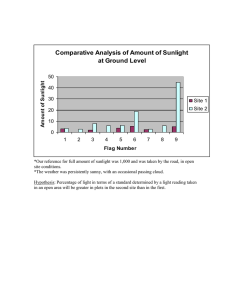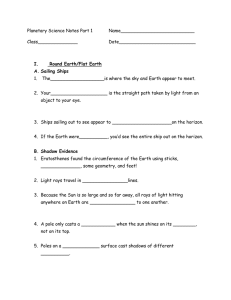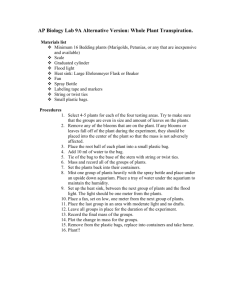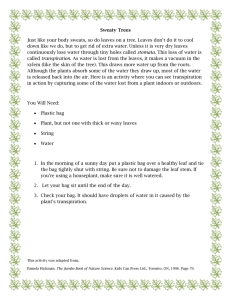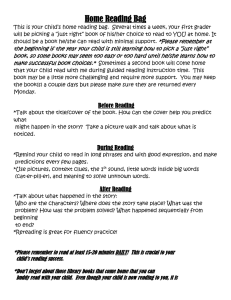LIGHT SECTION 4-SUNLIGHT PAPER AND SHADOWS MATERIALS:
advertisement
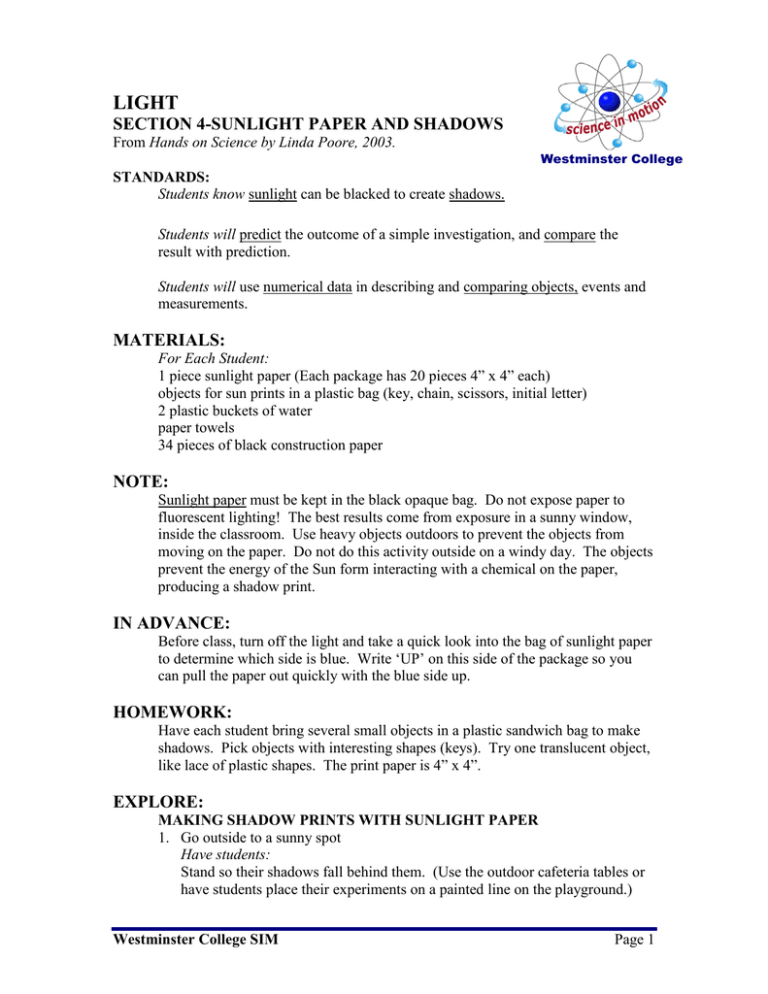
LIGHT SECTION 4-SUNLIGHT PAPER AND SHADOWS From Hands on Science by Linda Poore, 2003. Westminster College STANDARDS: Students know sunlight can be blacked to create shadows. Students will predict the outcome of a simple investigation, and compare the result with prediction. Students will use numerical data in describing and comparing objects, events and measurements. MATERIALS: For Each Student: 1 piece sunlight paper (Each package has 20 pieces 4” x 4” each) objects for sun prints in a plastic bag (key, chain, scissors, initial letter) 2 plastic buckets of water paper towels 34 pieces of black construction paper NOTE: Sunlight paper must be kept in the black opaque bag. Do not expose paper to fluorescent lighting! The best results come from exposure in a sunny window, inside the classroom. Use heavy objects outdoors to prevent the objects from moving on the paper. Do not do this activity outside on a windy day. The objects prevent the energy of the Sun form interacting with a chemical on the paper, producing a shadow print. IN ADVANCE: Before class, turn off the light and take a quick look into the bag of sunlight paper to determine which side is blue. Write ‘UP’ on this side of the package so you can pull the paper out quickly with the blue side up. HOMEWORK: Have each student bring several small objects in a plastic sandwich bag to make shadows. Pick objects with interesting shapes (keys). Try one translucent object, like lace of plastic shapes. The print paper is 4” x 4”. EXPLORE: MAKING SHADOW PRINTS WITH SUNLIGHT PAPER 1. Go outside to a sunny spot Have students: Stand so their shadows fall behind them. (Use the outdoor cafeteria tables or have students place their experiments on a painted line on the playground.) Westminster College SIM Page 1 SUNLIGHT PAPER AND SHADOWS Place their plastic bag in the Sun with their objects arranged on top of the bag. A cut out letter (initial) or number on each bag will make identification easier after soaking. 2. The teacher quickly slides a piece of sunlight paper, blue side up, under each plastic bag. Have students stand so they don’t cast a shadow on the experiments. 3. The students watch for 5 minutes or until the paper turns white. Have students predict what color the paper is under the objects. (It stays blue as the Sun did not affect the chemical.) [S, predict] 4. Once the paper turns white, have students pick it up quickly and submerge it in a bucket of water for 1 minutes. Have the bucket close to the experiments. After 1 minutes, remove the paper from the bucket. Let the print paper dry ‘face-down’ on a paper towel. 5. How did the paper change in the water? The paper turns blue and the shaded areas turn white . (images reverses) DEMONSTRATE: TESTING VARIABLES WITH SUNLIGHT PAPER 1. Predict what will happen if the paper is left in the Sun for one minute. What if the paper is left in the Sun for 20 minutes? Discuss the predictions. 2. Have 4 students set up their experiment again. Place sunlight paper under these bags and expose each paper for a different time period (e.g., 1 minute, 10, 15, and 20 minutes). Analyze results. Have students write 1, 10, 15, and 20 minutes on their paper and describe each print. (dark, too light, etc.) Discuss. 3. What other variables could you test with this experiment? (length of time in water) Have students design an experiment to test this variable. [S, sun-shadows][S, data] Westminster College SIM Page 2
